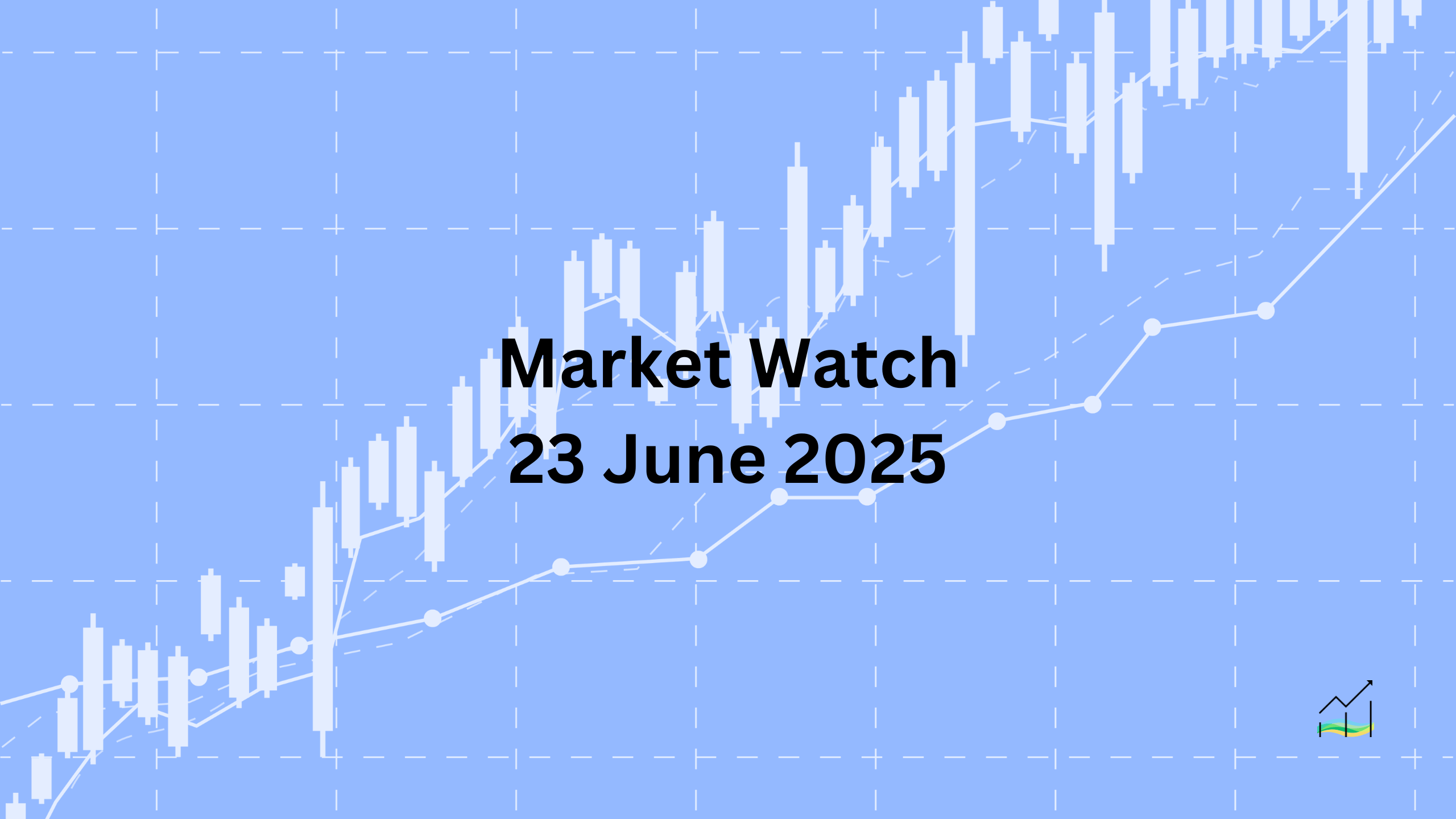23/06/2025 Market Watch

Geopolitical Tensions Rise, Dollar Extends Gains, Markets Turn Cautious
Key Takeaways:
- US strikes on Iran have heightened geopolitical risks, but full damage remains unclear
- Market reactions are mixed: gold softens, WTI crude slips from recent highs
- US dollar rallies across G10 and emerging market currencies
- Equity sentiment remains cautious with Asia mostly lower, US futures slightly positive
- Fed speakers, including Chair Powell, could shape rate expectations this week
Markets are on edge following a US strike on Iran, carried out with strategic ambiguity. While the operation inflicted damage, there is no confirmation on whether Iran’s nuclear capabilities were significantly impaired. Attention now shifts to Tehran’s response, which could further escalate tensions. Despite the uncertainty, gold has eased slightly and crude oil prices, particularly August WTI, have retreated from highs near $78.40 to around $74.
Currency markets are showing a clear risk-off tone, with the US dollar advancing strongly against both G10 and emerging market currencies. Losses are most pronounced in the Australian dollar, New Zealand dollar and Japanese yen, each falling over 1%. The Swiss franc and Canadian dollar are relatively more stable. This move reflects an extension of the dollar’s upside correction that began last week.
In equities, sentiment is mixed. Most Asia Pacific markets declined, except for Hong Kong and mainland China. The regional MSCI index recorded its first weekly drop in three weeks. In Europe, the Stoxx 600 is trading slightly lower after two consecutive weekly losses. US futures are showing some resilience, but the S&P 500 and NASDAQ have fallen for two straight weeks. Bond markets are seeing modest upward pressure on yields, with US 10-year rates near 4.38% and similar small gains in Europe and Japan.
Markets now turn to a heavy slate of Federal Reserve speakers, including Chair Jerome Powell’s testimony before Congress. His comments will be scrutinised for any guidance on the Fed’s policy outlook amid growing geopolitical risk and diverging global growth dynamics.
United States of America
Overview
The US dollar strengthened significantly last week, climbing from just below 97.70 to over 99.15 before settling near 99.30–99.40 in Monday's European session. The technical trend appears firm as the five-day moving average approaches a crossover above the 20-day average. However, the broader economic picture remains uncertain. The Federal Reserve continues to downplay the significance of soft survey data, placing more weight on hard economic indicators.
Despite the Fed’s composed stance, recent data shows signs of a slowdown. The labor market is cooling, with the four-week average of jobless claims reaching 245,500, the highest since August 2023. Consumption is weakening under the weight of tariffs, declining confidence, and reduced job security. This is evident in May’s retail sales, which posted their second consecutive monthly decline, and in industrial production, which has now contracted in two of the past three months.
Markets are now closely watching how Fed officials respond to the economic drag and potential oil price shocks. Chair Powell’s congressional testimony this week will be a key focus, along with any comments from the six Fed members scheduled to speak today. The upcoming preliminary June PMIs are also on the radar, though the Fed’s dismissive view on surveys may mute market impact.
Economic Drivers
- The Federal Reserve maintains a cautious stance, prioritising hard data over soft surveys.
- Jobless claims indicate a weakening labour market, with four-week averages at a 10-month high.
- Consumer sentiment is declining due to tariffs, household financial pressure, and labour market uncertainty.
- Retail sales are weakening, marking back-to-back declines.
- Industrial output remains sluggish, with contraction in two of the past three months.
Data and Events
- 23 June 2025: FOMC Members Speaks.
- 23 June 2025: Flash Manufacturing & Services PMI.
- 23 June 2025: Existing Home Sales.
Price Action
- Dollar Index rebounded from sub-97.70 levels to over 99.15 last week, now holding near 99.30–99.40.
- Five-day moving average is crossing above the 20-day average, supporting bullish momentum.
- Market shows cautious consolidation ahead of Powell’s testimony and PMI data.
Key Points:
- Dollar gains reflect strong technical bias, though macro headwinds are rising.
- Fed's focus on hard data puts added weight on consumption and labour market trends.
- Upcoming Fed commentary and PMIs may shape short-term rate expectations.
- Slowing economic indicators raise questions about growth sustainability.
Australia
Overview
The Australian dollar came under renewed selling pressure before the weekend, failing to hold gains near $0.6500 and closing at its lowest level this month. It extended losses on Monday, dropping below $0.6400 and briefly touching $0.6380 in European trading. Price action now eyes support near the previous month’s low around $0.6355.
Economic indicators are sending mixed signals. On the positive side, Australia’s composite PMI rose to 51.2 in June, marking its first monthly improvement in three months and remaining above the neutral 50 level since late Q3 2024. However, market attention is turning toward the upcoming May CPI release, which could influence the Reserve Bank of Australia’s next move.
Rate cut expectations remain firm. Futures markets are pricing in an 80% chance of a rate cut at the RBA’s July 8 meeting. Two additional cuts are nearly fully priced in before year-end, suggesting the overnight cash rate may fall to 3.10%. Swaps markets imply a roughly 40% chance of another reduction early next year, which could signal the end of the current easing cycle.
Economic Drivers
- Composite PMI rose to 51.2, the first monthly increase in three months.
- The PMI has stayed above the neutral 50 level since Q3 2024, pointing to modest expansion.
- May CPI report will be critical for monetary policy expectations.
- Markets anticipate further policy easing by the Reserve Bank of Australia.
- Overnight cash rate may fall to 3.10% by year-end, with potential for another cut early next year.
Data and Events
- 23 June 2025: Flash Manufacturing & Services PMI.
Price Action
- Australian dollar rejected from near $0.6500 and closed at a monthly low last week.
- Extended losses below $0.6400, reaching around $0.6380 during European trade.
- Key support lies near the May low at approximately $0.6355.
Key Points:
- AUD pressured by policy easing expectations and weak price momentum.
- PMI improvement offers some support but is overshadowed by rate outlook.
- May CPI will be the focal point for short-term direction.
- Markets are positioned for at least three RBA rate cuts through early 2026.
Canada
Overview
The Canadian dollar saw strong gains earlier this month, reaching a ten-month high around $0.7850 (CAD1.3540). However, momentum has shifted sharply. After peaking, the currency has posted four consecutive days of losses, with the US dollar reclaiming strength and settling above key technical levels. The greenback finished last week at its highest since late May and is now testing the CAD1.3800 level, with resistance seen near the May high around CAD1.3865.
Attention now turns to Canada’s upcoming May CPI release. Market expectations are centred on a 0.5% monthly rise, which would likely bring the annual inflation rate to around 1.7%. Despite recent headline softness, the Bank of Canada remains focused on underlying inflation metrics. When the central bank held rates steady at 2.75% earlier this month, it cited persistent strength in core inflation, with median and trimmed mean CPI readings averaging just over 3.1% in April. These figures mark the highest levels since Q1 2024.
The Bank of Canada’s easing cycle began last June, when the overnight rate stood at 5.0%. Markets now see one final rate cut likely toward the end of the year. The direction of monetary policy will depend heavily on the evolution of core inflation, which remains well above target.
Economic Drivers
- Canadian dollar peaked at a ten-month high before reversing on broad US dollar strength.
- Bank of Canada kept the overnight rate at 2.75% in June, citing firm core inflation.
- Core CPI measures (median and trimmed mean) averaged just over 3.1% in April.
- Headline inflation is expected to remain low, but underlying pressures remain a concern.
- Market anticipates one final BoC rate cut before the end of 2025.
Data and Events
No major economic releases are scheduled today.
Price Action
- Canadian dollar reversed from ~$0.7850 (CAD1.3540), falling four sessions in a row.
- US dollar settled above its 20-day moving average for the first time since May 20.
- Five-day moving average is crossing above the 20-day average, confirming upside bias.
- USD/CAD testing 1.3800, with next resistance around 1.3865.
Key Points:
- Canadian dollar weakened after reaching a ten-month high.
- Core inflation remains above 3%, limiting scope for rapid rate cuts.
- CPI data will guide market expectations for the final BoC rate cut.
- USD/CAD bullish trend supported by technical momentum.
Europe
Overview
The euro regained some ground last week, rising nearly a cent after nearing the 20-day moving average around $1.1430. Early this week, it has found support near $1.1455, although the broader technical outlook remains sensitive. A break above the $1.1440 region could indicate a deeper correction is underway, potentially extending further.
On the economic front, European policymakers continue to focus on purchasing manager data as a key growth indicator. The eurozone composite PMI, which peaked at 50.9 in March after improving from last November’s low of 48.3, has since weakened. It stabilised in June at 50.2, with modest improvement in services and flat manufacturing activity. While this signals the economy remains narrowly in expansion territory, it is consistent with expectations for near-zero growth in the second quarter.
The Q1 2025 expansion of 0.6% is unlikely to be repeated, as headwinds from slower government spending and declining net exports weigh on output. Looking ahead, growth prospects remain limited for the second half of the year, with structural weakness across core sectors suggesting only modest momentum at best.
Economic Drivers
- Eurozone composite PMI held at 50.2 in June, after two months of decline.
- Services PMI rose slightly to 50.0, while manufacturing was unchanged at 49.4.
- The composite index points to stagnation in Q2 after 0.6% growth in Q1.
- Drag on growth coming from weaker government expenditure and poor trade performance.
- Outlook for H2 2025 remains weak, with little evidence of a strong recovery.
Data and Events
- 23 June 2025: Flash Manufacturing & Services PMI.
Price Action
- Euro rebounded from near $1.1430 to just above $1.1530 before the weekend.
- Support held early this week near $1.1455.
- A sustained break above $1.1440 could open room for further gains.
Key Points:
- Eurozone economy is hovering just above stagnation, with limited growth drivers.
- PMI readings show fragile expansion, mostly in services.
- Euro holding key technical support, with potential for correction continuation.
- Subdued outlook for the second half of 2025 remains intact.
Japan
Overview
The Japanese yen continued to weaken, with the dollar rising through each prior session's high last week and reaching a new monthly peak near JPY146.20 by Friday. The rally extended into Monday, where the dollar surged to nearly JPY147.95, marking the highest level since mid-May. Although momentum indicators are stretched, there is little relief in sight amid persistent economic fragility and external pressures.
Japan’s economy shrank at an annualised rate of 0.2% in Q1 and current data suggests Q2 will not see a full recovery. Industrial output fell by 1.1% in April, partially reversing gains from Q1, while exports increased by just 0.1% in May after a sharp 2.7% drop in April. Overall, exports were down 1.8% in Q1, reflecting global demand challenges. Despite these signs of weakness, the Bank of Japan held policy steady last week, opting for caution as uncertainty surrounding US trade policy looms, especially for Japan's auto industry.
Tensions between Japan and the US may intensify after Tokyo resisted Washington’s request to raise defence spending to 3.5% of GDP. Japan remains committed to a 2% target by 2027. On the positive side, the preliminary June composite PMI rose to 51.4 from 50.2, the highest reading since February. Notably, manufacturing PMI crossed above the 50 mark for the first time in over a year, offering a glimmer of stabilisation.
Economic Drivers
- Japan’s economy contracted 0.2% annualised in Q1, with Q2 unlikely to show a full rebound.
- Industrial output fell by 1.1% in April, weakening after Q1 gains.
- Exports edged up 0.1% in May following a 2.7% decline in April.
- The auto sector faces uncertainty amid potential US tariffs.
- Japan-US tensions rise over defence spending commitments, with Japan maintaining a 2% target by 2027.
- June composite PMI improved to 51.4, with manufacturing PMI above 50 for the first time since May 2023.
Data and Events
- 23 June 2025: Flash Manufacturing & Services PMI.
- 23 June 2025: BOJ Core CPI.
Price Action
- Dollar rose every day last week, peaking near JPY146.20 before weekend.
- USD/JPY surged to JPY147.95, highest since mid-May.
- Momentum indicators are stretched but trend remains bullish.
Key Points:
- Yen under pressure as economic weakness persists.
- Q2 growth outlook remains subdued with weak exports and industrial output.
- Bank of Japan maintains cautious stance amid geopolitical and trade uncertainties.
- PMI gains offer slight improvement, particularly in manufacturing.
- Rising tensions with the US over defence spending may affect bilateral relations.
United Kingdom
Overview
Sterling rebounded last week after dipping below $1.34 on June 19, briefly climbing above $1.35 before running into resistance near its 20-day moving average. The rally faded as the pound was sold back down to session lows near $1.3440 before the weekend and extended further to test support near $1.3370. A break of that level could accelerate losses toward the $1.3170–$1.3200 region.
The UK economy is beginning to show signs of slowing after a strong first quarter, where it led the G7 with 0.7% quarterly growth. Despite holding rates steady at its latest meeting, the Bank of England is widely expected to cut rates at its next decision on August 7. Market pricing now implies nearly an 80% chance of a rate reduction.
PMI data presents a mixed picture. The manufacturing sector remains in contraction, though the index rose for the third month in a row to 47.7. It has not breached the 50 level since September 2023. The services PMI climbed to 51.3 from 50.9, lifting the composite index to 50.7, its highest point in Q2. Nonetheless, the data reflects only modest growth and points to a fragile recovery.
Economic Drivers
- UK led the G7 with 0.7% Q1 GDP growth but momentum is now slowing.
- Bank of England held rates last week, but market expects a cut in August.
- Manufacturing PMI rose for a third straight month but remains in contraction.
- Services sector continues to expand modestly.
- Composite PMI edged up to 50.7, the strongest Q2 reading so far.
Data and Events
- 23 June 2025: Flash Manufacturing & Services PMI.
Price Action
- Sterling rose above $1.35 before stalling near the 20-day moving average at $1.3515.
- Rejected back to $1.3440 before weekend, now testing support at $1.3370.
- A break below support could target the $1.3170–$1.3200 region.
Key Points:
- UK growth momentum fading after strong Q1 performance.
- BoE likely to cut rates in August amid softer economic signals.
- PMIs show gradual improvement but remain below pre-2023 strength.
- Sterling is under pressure near key support with limited upside traction.
© 2025 SKONE Enterprise (003319453-V). All rights reserved.
The content on this site is for informational purposes only and does not constitute financial advice.


